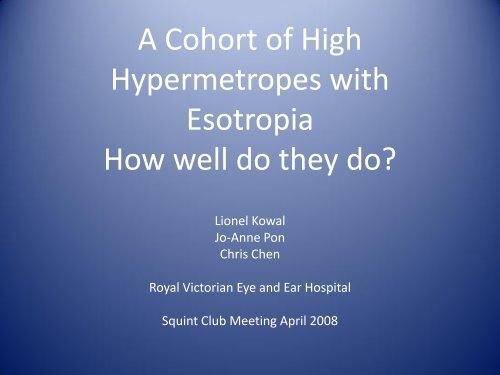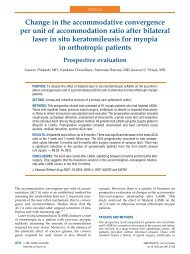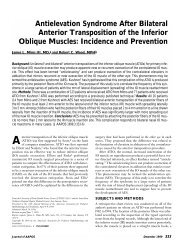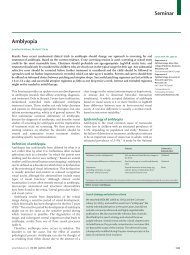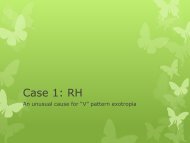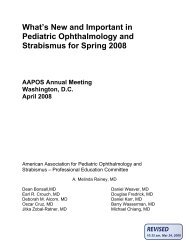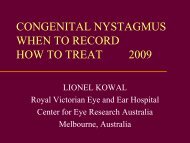High Hypermetropes and Progressive Hypermetropes in Esotropia ...
High Hypermetropes and Progressive Hypermetropes in Esotropia ...
High Hypermetropes and Progressive Hypermetropes in Esotropia ...
You also want an ePaper? Increase the reach of your titles
YUMPU automatically turns print PDFs into web optimized ePapers that Google loves.
A Cohort of <strong>High</strong><br />
<strong>Hypermetropes</strong> with<br />
<strong>Esotropia</strong><br />
How well do they do?<br />
Lionel Kowal<br />
Jo-Anne Pon<br />
Chris Chen<br />
Royal Victorian Eye <strong>and</strong> Ear Hospital<br />
Squ<strong>in</strong>t Club Meet<strong>in</strong>g April 2008
Method<br />
• 86 consecutive cases from private practice of<br />
strabismologist<br />
• Retrospective audit<br />
• <strong>High</strong> hypermetropia ≥6DS<br />
• With esotropia<br />
• <strong>Progressive</strong> hypermetropia (change <strong>in</strong><br />
refraction ≥1.5DS)
• Age of presentation<br />
• Follow-up<br />
• Visual acuities<br />
• Best Stereopsis<br />
Data<br />
• Refractive error (cycloplegic)<br />
• Ocular deviation – esotropia & cyclovertical<br />
• Surgery <strong>and</strong> response
• N=86<br />
Data<br />
• Follow-up<br />
Mean 20.2 months (0-216)
<strong>High</strong> Hypermetropia <strong>in</strong> Literature<br />
• Parks 1958<br />
– 143/897 = 16% (>5.25D & ET)<br />
• Abrahamsson 1992 (>5D & strabismus)<br />
– 2/49 = 4%<br />
– <strong>Progressive</strong> Hypermetropia<br />
• 5/41 (Δ by 2-3D), 3/41 (Δ by 1-
<strong>Progressive</strong> Hypermetropia <strong>in</strong><br />
• Abrahamsson 1992<br />
Literature<br />
– <strong>Progressive</strong> Hypermetropia<br />
• 5/41 (Δ by 2-3D), 3/41 (Δ by 1-
Average Age of Presentation<br />
• 2.6yrs – this study<br />
• Parks 1958 2.5yrs<br />
• Abrahamsson 1992 2-3yrs<br />
1. Abnormal Accommodative Convergence <strong>in</strong> Squ<strong>in</strong>t, Parks, Archives <strong>in</strong> Ophthalmology,<br />
1958;59 March<br />
2. Refraction changes <strong>in</strong> childhood develop<strong>in</strong>g convergent or divergent strabismus,<br />
Abrahamsson, BJO 1992;76:723-727
Age of Presentation (%)
Isoametropic Hyperopes<br />
Age of Presentation
Isoametropic Hyperopes<br />
Age of Presentation<br />
• Isoametropic Hyperopes present later<br />
• Klimek – 5yrs 1mo vs 3yrs 5 mo (all<br />
hyperopes)<br />
• Ziylan – 5.5 yrs vs 4.1 yrs (all hyperopes)<br />
• Not <strong>in</strong> this study<br />
– Majority before age 3<br />
Isoametropic Amblyopia Due to <strong>High</strong> Hyperopia <strong>in</strong> Children, Klimek et al, JAAPOS, 2004;8:310-313<br />
Isoametropic amblyopia <strong>in</strong> highly hyperopic children, Ziylan et al, Acta Ophthal Sc<strong>and</strong><strong>in</strong>avica 2007;
<strong>High</strong> Hyperopes & Amblyopia<br />
• Bilateral amblyopia (≤ 6/12)<br />
– 18% this study<br />
– 9% - Klimek (≥4.5D, no anisometropia ≥1.5D)<br />
• Responded well to Rx – glasses & patch<strong>in</strong>g<br />
• After Amblyopia Rx – achieved > 6/12<br />
– 86% - Klimek (≥6/12)<br />
– 83.9% - Ziylan<br />
– 83% - this study<br />
Isoametropic Amblyopia Due to <strong>High</strong> Hyperopia <strong>in</strong> Children, Klimek et al, JAAPOS, 2004;8:310-313<br />
Isoametropic amblyopia <strong>in</strong> highly hyperopic children, Ziylan et al, Acta Ophthal Sc<strong>and</strong><strong>in</strong>avica 2007;
• VA ≥ 6/7.5<br />
BCVA <strong>in</strong> better eye<br />
– 23/60 (38%) – this study (higher hypermetropia,<br />
≤1.5D anisometropia)<br />
– 58% Klimek (≥5D, ≤1.5D anisometropia)<br />
• Overall do high hypermetropes do worse?<br />
Isoametropic Amblyopia Due to <strong>High</strong> Hyperopia <strong>in</strong> Children, Klimek et al, JAAPOS, 2004;8:310-313
<strong>Progressive</strong> <strong>Hypermetropes</strong> & Amblyopia<br />
16/25<br />
9/25
<strong>Progressive</strong> Hypermetropia<br />
& BCVA <strong>in</strong> worse eye
BCVA better eye
Stereopsis<br />
• No difference between progressive hyperopes<br />
<strong>and</strong> non-progressive hyperopes
Age of Presentation<br />
& Best Sensory Fusion
Stereopsis<br />
• <strong>High</strong>er levels of stereopsis found <strong>in</strong> those who<br />
presented later<br />
• (rather than early detection <strong>and</strong> Rx)<br />
% with stereopsis<br />
– 89.3% - Mulvihill (range of hyperopia uncerta<strong>in</strong>)<br />
– 33% - this study<br />
Outcome <strong>in</strong> refractive accommodative esotropia, Mulvihill et al, BJO 2000; 84:746-749
<strong>Progressive</strong> Hyperopes & <strong>Esotropia</strong><br />
Size of deviation
Surgery & Size of Deviation
Surgery <strong>in</strong> fully accommodative ET<br />
• Decompensation of fully accommodative ET<br />
– 2.4% requires surgery (Mulvihill)<br />
– 1/40 = 2.5% (this study)<br />
Outcome <strong>in</strong> refractive accommodative esotropia, Mulvihill et al, BJO 2000; 84:746-749
<strong>Progressive</strong> Hyperopes & Surgery
Surgery<br />
• Rate 30/85 (35%)<br />
– 1 Operation: 24<br />
– 2 Operations: 5<br />
– 3 Operations: 1<br />
– Reoperation rate 6/24 (25%)<br />
• Reoperation rate of surgeon<br />
– BMR 10%<br />
–
Results for 6 patients unknown<br />
Surgery results
• N=86<br />
Cyclovertical Anomaly<br />
• Present 32 (37%)<br />
• None 54 (63%)
Cyclovertical anomaly
Differences between<br />
≥6DS & ET vs
<strong>Progressive</strong> vs Non-progressive<br />
hypermetropia<br />
<strong>Progressive</strong> hypermetropes more likely to<br />
• Have amblyopia - But responds well to Rx<br />
• More likely to have larger angle ET<br />
• More likely to require surgery<br />
• Less likely to have good results<br />
• <strong>Progressive</strong> hyperopes – not well reported <strong>in</strong> literature


